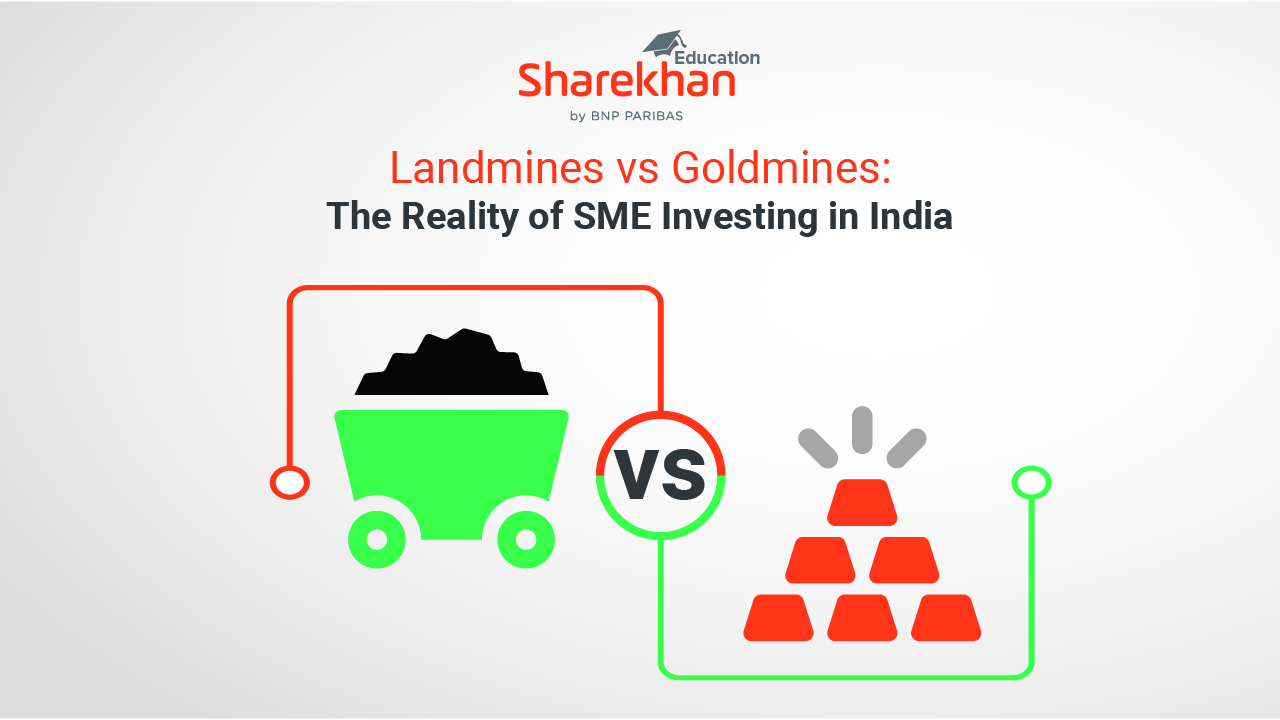Landmines vs. Goldmines: The Reality of SME Investing in India
Published by Sharekhan Education | October 30, 2024

Definition of SME:
SME Investing have played a pivotal role in India’s socio-economic development. The small enterprise is one which has annual turnover between INR 5 crores to INR 50 crores; with investment in plant and machinery to the extent of INR 1 crore to INR 10 crores. Medium enterprises are defined by a turnover that does not exceed INR 250 crores and the investment limit up to INR 50 crores per annum. It has been the prime contributor to employment generation, exports, innovation, and inclusive growth of the economy.
Overview SME IPOs:
An SME IPO is available to those small and medium enterprises whose post-issue paid-up capital ranges between ₹1 crore to ₹ 25 crores. According to the SEBI mandate, the minimum application size for SME IPOs must be ₹1 lakh on average. The promoters have also been mandated to hold a minimum equity capital of 20% after the IPO. The shares of these firms are listed on dedicated SME platforms like the SME platform by Bombay Stock Exchange and the Emerge SME platform by the National Stock Exchange. Both of them are regulated and created to suit specific needs of SMEs and provide a compliant environment for listing as well as trading in those instruments. This structure enables SMEs to reach a more comprehensive investor base and generate better scalability.
The first is that an SME’s IPO provides a source of acquiring capital from the public stock market. The actual use of funds raised can be for expansion, marketing, working capital, and general corporate purposes. Unlike bank loans, no repayment is implied as the capital raised is long-term. The public listing further increases the company’s visibility and enhances its brand reputation. Moreover, being listed on the stock market also enhances the ability of an SME in raising debt because banks and NBFCs prefer to lend to a listed company on more favorable terms due to higher transparency and market accountability.
Difference Between a Mainboard IPO and an SME IPO:
In the scale of size, SME IPOs are relatively smaller compared to a Mainboard IPO. It pertains to companies with a lower market capitalization. With regard to listing requirements, regulation, costs, and reach into the markets, these are two different types. The listing requirements for a Mainboard IPO tend to be more stringent; the regulatory scrutiny faced is also more severe in comparison with an SME IPO; the former also offers a broader market. As such, for the Mainboard-listed companies, they have to present their financings at least quarterly, but in the case of SME-listed companies, only semiannually.
Advantages of Investing in SMEs:
Investing in an SME can generate a tremendous amount in terms of returns on investment and can provide a channel for investing in firms that enjoy a greater prospect of success and contributing significantly towards the general growth of the economy.
SMEs have greater growth prospects as compared to their larger counterparts in that they are agile and responsive to an alteration in the market. Portfolio diversification is also provided by investments in this sector. The SME sector is also a good attraction point for potential mergers and acquisitions in that bigger companies usually acquire smaller ones to spur their expansion. In order to acquire control of the SME, they can offer an existing shareholder a premium while taking over the company.
Risk Factors Associated With Investments in SMEs:
Investment in smaller firms indeed comes with a higher degree of risk.
Economies of scale are usually realized by larger firms whose sources of income are often diversified. Small businesses often do not have sufficient financial reserves to sustain inevitable losses if business deteriorates. Moreover, SME stocks are less liquid as compared to regular stocks because they are lesser known and also not traded as frequently, hence more volatile with wider bid-ask spreads. The positive aspect is that the SME stocks are hardly covered by the brokerage firms, and hence not much information is available for proper analysis.
Conclusion:
Thus, there are sample opportunities which unfold before the investor through an SME IPO. However, along with a higher return, the investors encounter several risks, such as low liquidity and high volatility. Therefore, Sharekhan Education recommends an approach towards SME investing that is balanced between research, risk assessment, and diversification. Such an action not only benefits the investors through the growth of SMEs but is also beneficial to the country’s economy at large.
Disclaimer
Investment in securities market are subject to market risks, read all the related documents carefully before investing. For detailed disclaimer and registered office details visit link –
https://www.sharekhan.com/disclaimer/Sharekhan_Education.html




